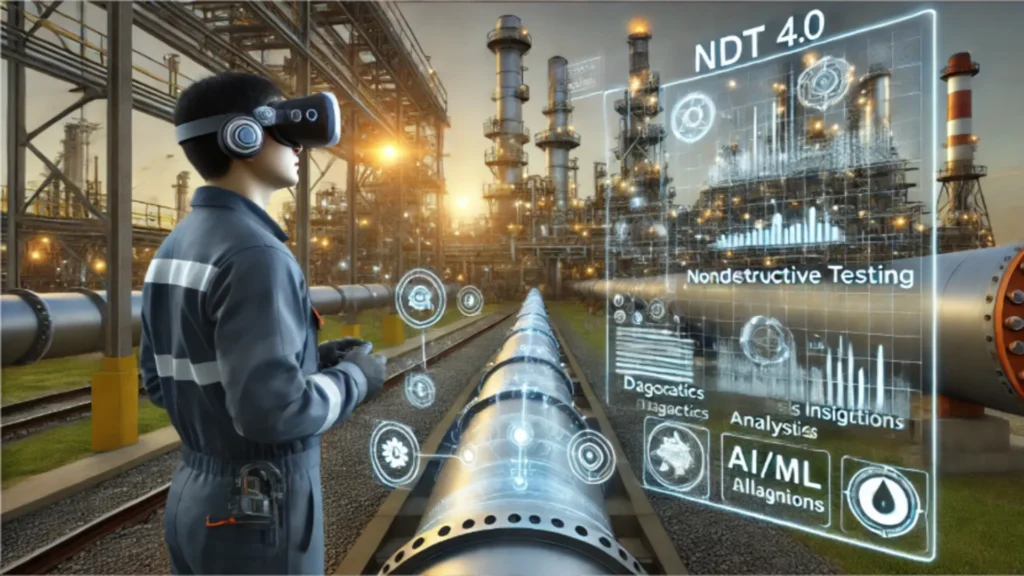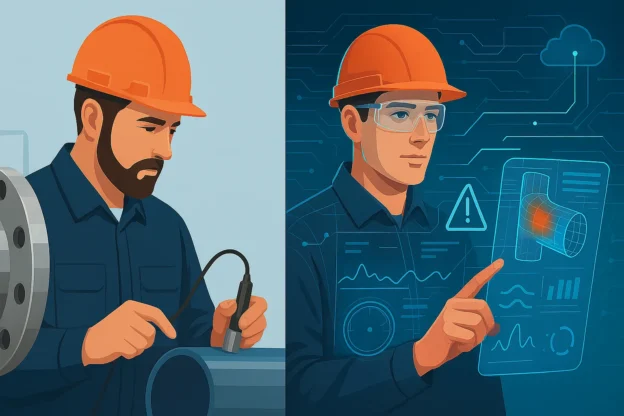Table of Contents
- IoT Sensors: Real-time data for proactive maintenance
- Technology as a service (TaaS) and software as a service (SaaS): cloud-based solutions
- Remote Monitoring and Assisted AI/ML: The Role of AI in NDT
- Augmented reality (AR) and digital imaging: Enhanced visualization for precision inspections
- Addressing the skills gap: The evolving role of the NDT technician
- Conclusion: Embracing the future of NDT
The rise of NDT 4.0 marks a significant shift in the Non-Destructive Testing (NDT) industry, transforming inspection techniques and redefining the roles of technicians in the field. With the incorporation of Internet of Things sensors, Technology as a Service (TaaS), Software as a Service (SaaS) and remote monitoring technologies, the NDT industry is becoming more data-driven, automated and efficient than ever before.
This development comes at an opportune time, as the industry faces a shortage of qualified technicians and a growing demand for detailed, real-time analysis of assets.
IoT Sensors: Real-time data for proactive maintenance
One of the pillars of NDT 4.0 is the use of IoT-enabled sensors. These devices continuously monitor critical assets and transmit data to centralized platforms, where anomalies can be detected in real time.
IoT sensors, embedded in equipment, pipes or structures, collect valuable information on factors such as temperature, vibration, corrosion and stress, providing early warnings of potential problems. This allows industries to adopt a proactive, condition-based maintenance approach, rather than reactive or scheduled maintenance.
For NDT technicians, this means less time spent on routine field inspections and more time analyzing data from centralized or mobile platforms. Instead of laborious on-site testing, technicians can monitor asset status remotely, traveling only when necessary for repairs or critical issues.
Technology as a service (TaaS) and software as a service (SaaS): cloud-based solutions
The adoption of TaaS and SaaS is redefining how inspections and data are managed in NDT. TaaS platforms allow companies to outsource their testing or assessment needs to cloud service providers. Complex analysis, anomaly detection and recommendations can then be performed without the need for on-site personnel.
SaaS, on the other hand, enables NDT data to be managed, analyzed and interpreted through cloud-based software. These platforms are highly scalable, ensuring that companies can handle growing volumes of data with ease. In addition, with the support of Artificial Intelligence (AI) and Machine Learning (ML), SaaS automates data analysis, reducing the burden on technicians and allowing them to focus on interpreting results and making critical decisions.
Remote Monitoring and Assisted AI/ML: The Role of AI in NDT
One of the biggest advantages of IoT and SaaS-based solutions is the integration of AI and ML for assisted data analysis. Through AI-driven algorithms, these systems can analyze large volumes of data, recognize patterns, identify defects and even predict potential failures.
For modern NDT technicians, this involves a shift in roles from data collection in the field to a focus on monitoring and quality control. AI reduces manual analysis time, highlights critical information and generates preliminary reports.

Augmented reality (AR) and digital imaging: Enhanced visualization for precision inspections
Augmented Reality (AR) is beginning to transform NDT by overlaying digital images directly onto physical assets. Technicians can use AR glasses to visualize defects in real time, enabling more accurate and efficient inspections.
Addressing the skills gap: The evolving role of the NDT technician
As NDT 4.0 technologies transform traditional processes, the role of the NDT technician evolves into data interpretation, digital management and monitoring. While it does not eliminate the need for technicians, it expands their skills and positions them as supervisors who leverage technology to deliver faster and more accurate results.
Conclusion: Embracing the future of NDT
The implementation of NDT 4.0 marks a new era in Non-Destructive Testing, offering a sustainable path to meet today’s challenges while raising the quality and efficiency of inspections. Combining human expertise with advanced technologies, the future of NDT promises to be robust, reliable and highly efficient.
This article was developed by specialist Joshua de Monbrun and published as part of the fourth edition of Inspenet Brief magazine December 2024, dedicated to technical content in the energy and industrial sector.

